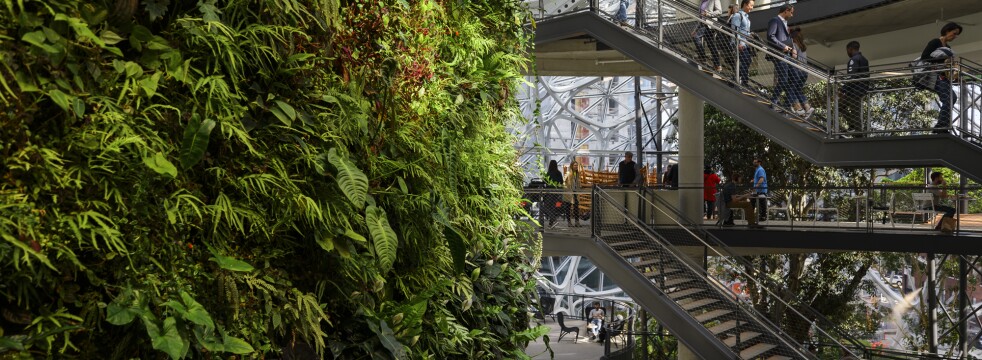Buildings
We operate thousands of world-class facilities that serve our employees, customers, and communities across the globe. We’re reducing emissions across our portfolio by increasing the energy efficiency of our buildings, expanding our use of renewable energy, and using more-sustainable building materials.



We leverage industry best practices and emerging technologies in facility design and operation to drive reductions across carbon, energy, water, and waste.
We focus on the direct emissions that result from powering our buildings, as well as the indirect emissions from the embodied carbon—the carbon emitted during construction—in our building materials and equipment. We use proven technologies to enhance efficiency across our facilities and pilot new ideas, including innovations supported by The Climate Pledge Fund, to transition our buildings to net-zero carbon.
We employ a variety of sustainability strategies across our different building types, which include corporate offices, fulfillment facilities, physical stores, and data centers.
Our global corporate offices are often located in vibrant communities and urban hubs. Many of our corporate buildings offer plazas and open green spaces for communal and public use. Even more feature green roofs and other green infrastructure that provide outdoor amenity space while supporting ecological functions like green stormwater management.
Indoor spaces integrate biophilic design concepts, such as green walls and locally sourced woods, along with energy-efficient lighting, composting and recycling, and amenity spaces for employee wellness. Many of our buildings also offer plug-in electric vehicle charging stations, bike parking, and showers to encourage low-carbon transportation for employees and visitors.
We’ve also worked with the owners of small businesses that will occupy the 50,000 square feet of retail space on campus to reduce the carbon impact of their operations. As part of our leasing process, we worked with tenants to explore electrification and help them understand how to move away from fossil fuel consumption. We’re proud that 100% of our retail spaces will be all-electric, including restaurants and other food services.
Our fulfillment, logistics, and distribution sites are state-of-the-art facilities where we process orders for our customers. We use an Enterprise Building Management System (EBMS) to optimize energy use in many of our facilities. We conduct regular lighting and EBMS retrofits, and we replace rooftop heating, ventilation, and air conditioning (HVAC) units to continually improve the energy efficiency of these facilities.
Many of our fulfillment facilities throughout the U.S., Europe, and India are powered by on-site solar, where a rooftop installation can power up to 80% of the facility’s energy use. We’re also pursuing Zero Carbon Certification status at some fulfillment facilities through the International Living Future Institute. The certification requires locations to lower energy use, eliminate on-site gas combustion, and build using lower-carbon materials.
Our portfolio of physical stores includes hundreds of Whole Foods Market, Amazon Fresh, and Amazon Go locations across the U.S. and Europe.
In 2022, Whole Foods Market reached a milestone in energy efficiency performance, achieving the U.S. Department of Energy Better Buildings Challenge goal two years ahead of schedule. These energy efficiency improvements were driven by investing in alternative refrigerants with lower global warming potential, installing energy-efficient HVAC systems, implementing retrofit projects, and launching an energy awareness program for store operations.
We’re making similar energy efficiency improvements across our stores. We’re introducing natural refrigeration and electrifying systems that traditionally run on natural gas, including kitchen equipment, water heaters, and HVAC systems. Several of our Amazon Go stores are also seeking Zero Carbon Certification, the first of which is an Amazon Fresh store in North Seattle, near our Puget Sound headquarters.









